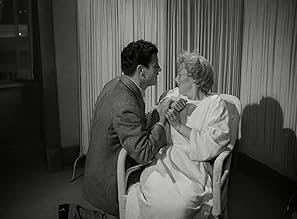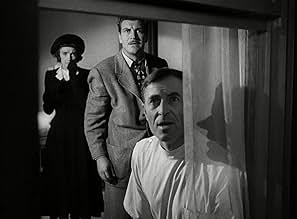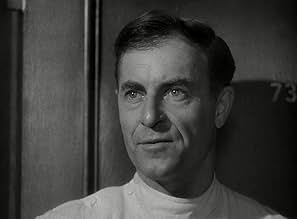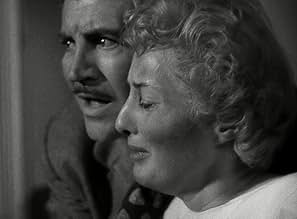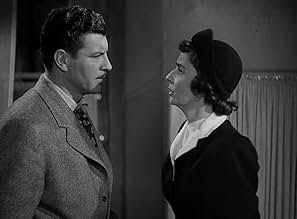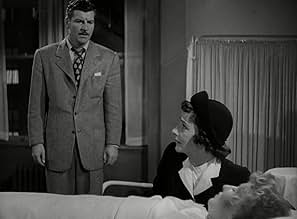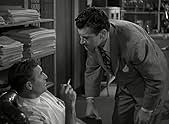CALIFICACIÓN DE IMDb
6.6/10
1.2 k
TU CALIFICACIÓN
Agrega una trama en tu idiomaA desperate husband tries to find help for his wife suffering from addictive gambling.A desperate husband tries to find help for his wife suffering from addictive gambling.A desperate husband tries to find help for his wife suffering from addictive gambling.
- Dirección
- Guionistas
- Elenco
- Premios
- 3 premios ganados en total
Philip Van Zandt
- Chuck
- (as Phil Van Zandt)
Tony Curtis
- Bellboy
- (as Anthony Curtis)
Peter Leeds
- Jack Harrison - Hotel Clerk
- (as Peter Lewis)
Opiniones destacadas
Despite some of the reviews here that characterize TLG as trite and dated, I only thought this film was a directorial surprise, way ahead of its time for 1949.
First you start with a flashback by Preston's character that isn't quite a flashback, because we are more interested in who this man is and what the circumstances of his plight are, than the past per se. Virtually all Hollywood flashbacks seem to involve some grand police confession or some need to explain the confessor (such as "D.O.A.")but the flashback here seems to add to the convolutedness of the characters, and the surrealism of the situation. Does Preston really understand his wife? If so when? The flashback reminds us that there is more to explain than the "what",but also the "why" which neither Preston nor the audience yet understand (gambling is a disease, but the matter of guilt and personal responsibility for misdeeds remain open).
More convolutedness in the photography. Carefully cropped chest-up body shots, with swirling camera movements amid authentic but claustrophobic interiors. Remember, only Max Ophuls was supposed to have done this sort of thing at the time! I remember "Leaving Las Vegas" attempted the same themes in slightly different ways (misery and anomie in a spectacular setting) but that was a miserable film.
Finally you have a not so sweet resolution to depict insanity, but in a much subtler way than "The Snake Pit" and other entries in the growing body of 'social consciousness' films. Stanwyck was a tough-soft actress, and the scenes where she rolls before a throng a gamblers rarely came tougher in her films. A work to just watch.
First you start with a flashback by Preston's character that isn't quite a flashback, because we are more interested in who this man is and what the circumstances of his plight are, than the past per se. Virtually all Hollywood flashbacks seem to involve some grand police confession or some need to explain the confessor (such as "D.O.A.")but the flashback here seems to add to the convolutedness of the characters, and the surrealism of the situation. Does Preston really understand his wife? If so when? The flashback reminds us that there is more to explain than the "what",but also the "why" which neither Preston nor the audience yet understand (gambling is a disease, but the matter of guilt and personal responsibility for misdeeds remain open).
More convolutedness in the photography. Carefully cropped chest-up body shots, with swirling camera movements amid authentic but claustrophobic interiors. Remember, only Max Ophuls was supposed to have done this sort of thing at the time! I remember "Leaving Las Vegas" attempted the same themes in slightly different ways (misery and anomie in a spectacular setting) but that was a miserable film.
Finally you have a not so sweet resolution to depict insanity, but in a much subtler way than "The Snake Pit" and other entries in the growing body of 'social consciousness' films. Stanwyck was a tough-soft actress, and the scenes where she rolls before a throng a gamblers rarely came tougher in her films. A work to just watch.
From 1949, The Lady Gambles stars Barbara Stanwyck, Robert Preston, and Stephen McNally.
Stanwyck plays Joan Boothe, who accompanies reporter husband David (Preston) to Las Vegas where he is working on a story about the Hoover Dam. Left to her own devices, she becomes interested in gambling to the point where it becomes an addiction. Though she tries to fight it, she can't, and ultimately loses her husband and falls into the clutches of Horace Corrigan, who runs the casino and has her number.
Stanwyck does well showing Joan's downward spiral. The film dabbles in psychology in Joan's relationship with her older sister Ruth (Edith Barrett) for whom she takes responsibility, though her husband objects.
Good performances all around, as well as some brutal and scary moments. Definitely keeps your interest.
Watch for Tony Curtis in one of his first speaking roles as a telegram delivery boy. The director told him, "All you want is a tip." He's adorable.
Stanwyck plays Joan Boothe, who accompanies reporter husband David (Preston) to Las Vegas where he is working on a story about the Hoover Dam. Left to her own devices, she becomes interested in gambling to the point where it becomes an addiction. Though she tries to fight it, she can't, and ultimately loses her husband and falls into the clutches of Horace Corrigan, who runs the casino and has her number.
Stanwyck does well showing Joan's downward spiral. The film dabbles in psychology in Joan's relationship with her older sister Ruth (Edith Barrett) for whom she takes responsibility, though her husband objects.
Good performances all around, as well as some brutal and scary moments. Definitely keeps your interest.
Watch for Tony Curtis in one of his first speaking roles as a telegram delivery boy. The director told him, "All you want is a tip." He's adorable.
Robert Preston (David) tracks down his wife Barbara Stanwyck (Joan) in hospital after she has been beaten up. He pleas with John Hoyt (Dr Rojac) to let her go home with him after she has been treated rather than hand her over to the police where she has several outstanding charges. In flashback, we watch the story of her descent into gambling addiction after a visit to Las Vegas.
The film is interesting to watch for the location settings. I actually bought it specifically for the Las Vegas setting as it is where I got married earlier this year and I wanted to make a comparison with 1949. The story was incidental. As it turns out, the story is OK if predictable. Stanwyck carries the film with good support from gangster Stephen McNally (Mr Corrigan). Robert Preston changes his tune during the course of the film as he swings from rejecting her to accepting her while the role of Stanwyck's sister Edith Barrett (Ruth) is pretty annoying and some sentimental pop psychology is dragged into the proceedings.
I'm sure that the inspiration behind the Las Vegas section of the film was Bugsy Siegel and his Flamingo Hotel which paved the way for the notoriety of the Strip. The main body of the film is set in the Pelican Hotel (a bit similar?) and McNally has an interest in a horse racing scam just as Bugsy did.
The film ends in a disappointingly corny way after a funny moment when John Hoyt shows us what to say to someone when they are about to jump off a window ledge. I dare you to try it some day! As for the film's climax, we have to hopefully imagine that everything will go downhill again once they return to Vegas and hit the casinos.
The film is interesting to watch for the location settings. I actually bought it specifically for the Las Vegas setting as it is where I got married earlier this year and I wanted to make a comparison with 1949. The story was incidental. As it turns out, the story is OK if predictable. Stanwyck carries the film with good support from gangster Stephen McNally (Mr Corrigan). Robert Preston changes his tune during the course of the film as he swings from rejecting her to accepting her while the role of Stanwyck's sister Edith Barrett (Ruth) is pretty annoying and some sentimental pop psychology is dragged into the proceedings.
I'm sure that the inspiration behind the Las Vegas section of the film was Bugsy Siegel and his Flamingo Hotel which paved the way for the notoriety of the Strip. The main body of the film is set in the Pelican Hotel (a bit similar?) and McNally has an interest in a horse racing scam just as Bugsy did.
The film ends in a disappointingly corny way after a funny moment when John Hoyt shows us what to say to someone when they are about to jump off a window ledge. I dare you to try it some day! As for the film's climax, we have to hopefully imagine that everything will go downhill again once they return to Vegas and hit the casinos.
In this B-picture that shows a woman's discovery of gambling, Barbara Stanwyck shines in the leading role. Released the same year as Gregory Peck's gambling movie The Great Sinner, this is the female version of the dangers of gambling. Robert Preston costars as the long-suffering husband, and Stephen McNally is a very realistic villain who entices Barbara to start trying her luck. If you keep your eyes peeled, you can catch a very young Tony Curtis in his third film appearance! He plays a bellboy and is onscreen for less than ten seconds, but he has an interaction with the legendary Barbara Stanwyck; not bad!
The opening scene is incredibly engaging and shocking. Barbara walks out into an alley, then gets beaten by a group of thugs and left for dead. Next, Robert Preston runs into a hospital, demanding to know how his wife is. He tells the doctor in charge, and the audience, the story of how she ended up this way. While the storytelling method is a little cheesy, Barbara's performance more than makes up for it. She's fantastic, and completely in her element as she's given the opportunity to show off every human emotion throughout the film. She's innocently curious as she tags along on her husband's business trip to Las Vegas, and her slow descent into addiction is riveting. She's deceitful, ashamed, devious, desperate, and completely unable to stop. Her eyes light up when she wins, and she feels like her life's over when she loses. If you've never seen a Barbara Stanwyck movie, this is a great place to start.
The opening scene is incredibly engaging and shocking. Barbara walks out into an alley, then gets beaten by a group of thugs and left for dead. Next, Robert Preston runs into a hospital, demanding to know how his wife is. He tells the doctor in charge, and the audience, the story of how she ended up this way. While the storytelling method is a little cheesy, Barbara's performance more than makes up for it. She's fantastic, and completely in her element as she's given the opportunity to show off every human emotion throughout the film. She's innocently curious as she tags along on her husband's business trip to Las Vegas, and her slow descent into addiction is riveting. She's deceitful, ashamed, devious, desperate, and completely unable to stop. Her eyes light up when she wins, and she feels like her life's over when she loses. If you've never seen a Barbara Stanwyck movie, this is a great place to start.
Stanwyck's was a curious career. The highest-paid woman in pictures -- actually, in America -- for a while, she made her share of workaday, forgettable pictures. The Lady Gambles is among them, except that it stars Stanwyck. Married to Robert Preston, a reporter doing a feature on Las Vegas, she agrees to help out by getting in on the action. Soon, she's hooked, playing recklessly and compulsively even as her marriage is disintegrating. There's one brutal scene when she's beaten up by thugs in an alley -- not a scene often filmed with a top actress as victim. The film has a historical interest as one of the first to be set in that new Babylon in the desert, Las Vegas. (In the 30s, the only Nevada location was Reno; Vegas was still a chicken run.) Despite its semi-documentary approach, The Lady Gambles sustains interest; as a look at abnormal gambling, it's better than Gambling House (with Victor Mature) or The Las Vegas Story (with Mitchum and Jane Russell).
¿Sabías que…?
- TriviaThe scene where Corrigan (Steven McNally) tells the girls "No-one uses my first name....because it's Horace" could well have been an in-joke as Stephen McNally's birth name was Horace Vincent McNally.
- ErroresReflected in the bus window that Joan is on.
- Citas
Joan Phillips Boothe: May I come in?
Barky: Ask a foolish question, and you get a foolish answer.
Selecciones populares
Inicia sesión para calificar y agrega a la lista de videos para obtener recomendaciones personalizadas
- How long is The Lady Gambles?Con tecnología de Alexa
Detalles
- Fecha de lanzamiento
- País de origen
- Idiomas
- También se conoce como
- The Lady Gambles
- Locaciones de filmación
- Hoover Dam, Arizona-Nevada Border, Estados Unidos(Second unit)
- Productora
- Ver más créditos de la compañía en IMDbPro
- Tiempo de ejecución1 hora 39 minutos
- Color
- Relación de aspecto
- 1.37 : 1
Contribuir a esta página
Sugiere una edición o agrega el contenido que falta

Principales brechas de datos
By what name was Prisionera del azar (1949) officially released in India in English?
Responda
